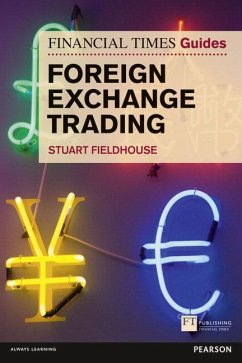
Financial Times Guide to Bond and Money Markets, The
Versandkostenfrei!
Versandfertig in 2-4 Wochen
54,99 €
inkl. MwSt.
Weitere Ausgaben:

PAYBACK Punkte
27 °P sammeln!
This jargon-busting book shows how bond & money markets work & how they impact on everyday life.
Understand terms & products
Explore types of markets & their functions
Discover factors influencing market prices
Learn how fluctuations can affect your money strategies
Product Description
This jargon-busting book describes how the bond and money markets work and how they impact on everyday life. It assumes no specialised prior knowledge of finance theory and provides an authoritative and comprehensive run-down of the workings of the modern financial system.
It’s in the money markets where money, or the value of money, can be bought and sold. It’s the place where Treasury bills, deposits, repurchase agreements, short-lived mortgages etc, can be traded. These are crucial to the global economy because they provide liquidity funding for the global financial system.
Bond markets operate in the same way but are financial markets where participants can issue new debt or buy and sell existing debt – known as bonds. As with money markets, bond markets are key because they provide money where no money previously existed (think of your mortgage).
Using real world examples from media such as the Financial Times, bestselling author Glen Arnold gives an international perspective on these markets.
Understand key bond and money market terms and banking products
Explore the wide variety of types of markets and their functions eg. LIBOR, gilts, government debt
Gain insight into the main factors influencing prices in the financial markets
Learn how fluctuations in the money markets can affect you and your own money strategies
Backcover
The Financial Times Guide to Bond and Money Markets is your definitive introduction to the financial marketplace. This book provides an authoritative and comprehensive guide to the workings of the modern financial system. It will help you understand key bond and money market terms and will demystify the different types of markets, explain the role of money market instruments and reveal how fluctuations in the marketplace can affect you and your own money strategies.
The Financial Times Guide to Bond and Money Markets:
· Provides an easy-to-follow guide to bond and money markets
· Helps you understand the various markets and their functions
· Explains in-depth finance theory and mathematical structures
· Features comprehensive graphs and real case studies from the Financial Times
Preface
Part 1: An Overview
Chapter 1 – Introduction to Bond and Money Markets
Part 2: Bond Markets
Chapter 2 – Government Bonds
Chapter 3 – Government Bonds around the World
Chapter 4 – Corporate Bonds
Chapter 5 – Credit Ratings for Bonds
Chapter 6 – High-yield and Hybrid Bonds
Chapter 7 – International Bonds
Part 3: Money Markets
Chapter 8 – Interbank and Euro Currency
Chapter 9 – Treasury Bills and Commercial Paper
Chapter 10 – Repurchase Agreements and Certificates of Deposit
Chapter 11 – Bills of Exchange and Banker’s Acceptances
Part 4: Valuing Bonds and Money Market Instruments
Chapter 12 – Financial Concepts and Mathematics
Chapter 13 – Bond Valuation
Chapter 14 – Money Market Securities Valuation
Part 5: Some Variations on a Bond Theme
Chapter 15 – Securitisation
Chapter 16 – Central Banking Influences on Interest Rates
Understand terms & products
Explore types of markets & their functions
Discover factors influencing market prices
Learn how fluctuations can affect your money strategies
Product Description
This jargon-busting book describes how the bond and money markets work and how they impact on everyday life. It assumes no specialised prior knowledge of finance theory and provides an authoritative and comprehensive run-down of the workings of the modern financial system.
It’s in the money markets where money, or the value of money, can be bought and sold. It’s the place where Treasury bills, deposits, repurchase agreements, short-lived mortgages etc, can be traded. These are crucial to the global economy because they provide liquidity funding for the global financial system.
Bond markets operate in the same way but are financial markets where participants can issue new debt or buy and sell existing debt – known as bonds. As with money markets, bond markets are key because they provide money where no money previously existed (think of your mortgage).
Using real world examples from media such as the Financial Times, bestselling author Glen Arnold gives an international perspective on these markets.
Understand key bond and money market terms and banking products
Explore the wide variety of types of markets and their functions eg. LIBOR, gilts, government debt
Gain insight into the main factors influencing prices in the financial markets
Learn how fluctuations in the money markets can affect you and your own money strategies
Backcover
The Financial Times Guide to Bond and Money Markets is your definitive introduction to the financial marketplace. This book provides an authoritative and comprehensive guide to the workings of the modern financial system. It will help you understand key bond and money market terms and will demystify the different types of markets, explain the role of money market instruments and reveal how fluctuations in the marketplace can affect you and your own money strategies.
The Financial Times Guide to Bond and Money Markets:
· Provides an easy-to-follow guide to bond and money markets
· Helps you understand the various markets and their functions
· Explains in-depth finance theory and mathematical structures
· Features comprehensive graphs and real case studies from the Financial Times
Preface
Part 1: An Overview
Chapter 1 – Introduction to Bond and Money Markets
Part 2: Bond Markets
Chapter 2 – Government Bonds
Chapter 3 – Government Bonds around the World
Chapter 4 – Corporate Bonds
Chapter 5 – Credit Ratings for Bonds
Chapter 6 – High-yield and Hybrid Bonds
Chapter 7 – International Bonds
Part 3: Money Markets
Chapter 8 – Interbank and Euro Currency
Chapter 9 – Treasury Bills and Commercial Paper
Chapter 10 – Repurchase Agreements and Certificates of Deposit
Chapter 11 – Bills of Exchange and Banker’s Acceptances
Part 4: Valuing Bonds and Money Market Instruments
Chapter 12 – Financial Concepts and Mathematics
Chapter 13 – Bond Valuation
Chapter 14 – Money Market Securities Valuation
Part 5: Some Variations on a Bond Theme
Chapter 15 – Securitisation
Chapter 16 – Central Banking Influences on Interest Rates













